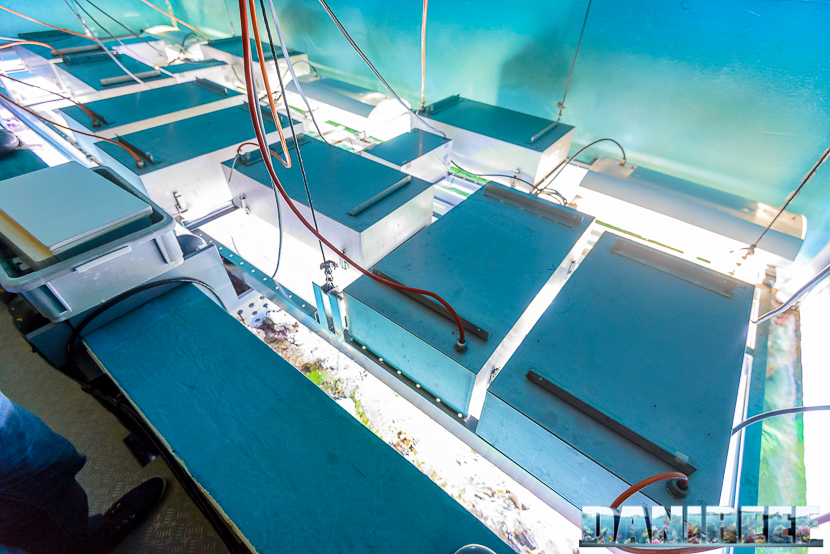
We have contacted the Zoo of Zurich, more precisely the doctor Martin Bauert, general responsible for the section in which lies a really particular installation that we are proud to show you and explain in detail (l’articolo in italiano dell’acquario del Masoala lo potete leggere cliccando qui).
The Zoo of Zurich is divided in several sections, following the different continents. The newest and more interesting part is the one you normally reach at the end: The Masoala.
The Zoo is really committed to the African island of Madagascar: with the goal of protecting one of the most interesting natural places in the world, it supports several projects in the forest of Madagascar, especially the National Park of Masoala, created in 1997 with a surface of 2400 km².
For this the Zoo actually took a little piece of Masoala forest to Switzerland: a greenhouse of 14.000 m² that replicate this forest by hosting 60 different species of animals and several hundreds species of plants. The view is spectacular and there is also the possibility to see some lemurs.
What the Zoo of Zurich didn’t forget is that this park is not only terrestrial and also includes some parts of the third biggest coral reef in the world.

To remember the presence of this coral reef to visitors, the curator of the Masoala section, the doctor Martin Bauert, that acted as our tour guide and gave us an interview, created a large reef tank to replicate the biotope of the Madagascar coastal.

The coral reef aquarium of Madagascar is impressive. It has a volume of 10 m² of water, that means 10.000 liters: 33 times a normal aquarium of 300 liters, just to make a comparison. The tank itself can be admired by visitors from the whole front side and a part of a short side. This aquarium hosts Small Polyped Stony (SPS) corals and Long Polyped Stony (LPS) corals but also fishes and soft corals, all these animals are originating from the coastal zone of Madagascar. As Bauert has explained to us the tank is open to public since 2003 but at the beginning it was not like we see it now (and like you can see in our pictures): the system is constantly evolving since its creation, like we are experiencing in our reef tanks. Also if we are speaking about an oversized reef aquarium, the dynamics of a 10.000 liters are really similar to our personal reef tanks. The SPS corals like Acropora, Montipora, Pocillopora, Stylophora, Seriatopora were inserted only in recent times, when a more modern management style enabled their survival beside LPS, soft corals and Tridacnas.

The management of this enormous aquarium is pretty simple, like Martin Bauert has explained to us, when everything is proportional to the size of tank. The main components are an hybrid lighting of HQi and T5, an oversized macro algae filter and an equally big protein skimmer. The style of management is based on the classical Berlin method, trying to keep the dynamics as stable as possible with a low number of fishes in the tank.

But let’s see how this aquarium is built.
The tank
The main tank is operating since 2003, it contains 8.500 liters of water and it is approximately 5.5 meters’ long. The whole system contains 10.000 net liters. The rear wall was painted in blue but now it is fully covered by a brown soft coral like a Xenia or an Anthelia. But this tank will be modernized in the next years. The soft coral will be completely removed and the back side will be painted with another color, more appropriated for an aquarium, furthermore there will be more space in order to clean the back side easily and avoid the growth of the corals, like we see it now.

Illumination system
Like we previously announced the light is composed of HQi and T5. In total we counted 3 HQi lamps of 1.000 watts and 10 with a power between 250 and 400 watts. The T5 tubes are used mainly to provide the blue light. There are 22 x 80 watts T5 tubes and 4 x 54 watt ones. This leads to a total of 8.000 watts, more or less. Like all reef keeper knows, this power gives concerns to the management of the tank. Therefore, doctor Martin Bauert is informing us that he is searching for alternatives in the new technologies that will help to reduce the amount of energy used and heat generated. A possibility could be a LED lighting, like the Orphek Atlantik P300 that with 250 watts could replace a 1.000 watts HQi, like successfully implemented in the MUSE reef aquarium in Trento (you can read it, albeit in italian, here).

The water flow
The whole water flow is generated by Tunze pumps. Four Tunze Turbelle Masterstream and three Tunze Turbelle Stream are responsible for the water motion in the tank. We speak of more than 200.000 liters per hour, that respects the classical rule of the Berlin Method which is to have a water flow of 20 times the volume of aquarium per hour in case of having SPS corals. The supervisor told us that the pumps should be rearranged since he noticed some area with low water flow and some area with too high flow. He also explains us that he would try to hide the pumps from the sight of visitors, since today they are placed on the left side of the frontal panel and easy to spot.












